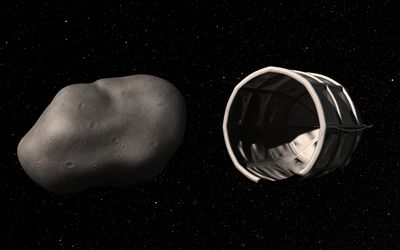Space merchants and planetary miningby Ayodele Faiyetole
|
| Planetary Resources “is establishing a new paradigm for resource utilization that will bring the solar system within humanity’s economic sphere of influence” by mining asteroids, Diamandis said. |
Considering the array of leaders of different industries that are backing Planetary Resources, one might consider this a done-deal success even before the start. The venture’s financiers include The Perot Group Chairman Ross Perot, Jr. and Larry Page, CEO of Google. Planetary Resources founders, Peter Diamandis and Eric Anderson, have already created one new space industry by pioneering the space tourism business with the founding of Space Adventures. The Planetary Resources backers include two-time space tourist and former Microsoft executive Charles Simonyi, Eric Schmidt and Ram Shriram of Google, and filmmaker James Cameron.
Diamandis said Planetary Resources “is establishing a new paradigm for resource utilization that will bring the solar system within humanity’s economic sphere of influence by enabling low-cost robotic exploration and eventual commercial development of asteroids.” Definitely, this is not the first time entrepreneurs are seeking to actively look “spaceward” with such “bold steps” to prospect, exploit and utilize its resources.
The Moon miners
Moon Express, Inc., which was selected by Forbes as one of the 15 “Names You Need to Know” in 2011, has made known its interest in prospecting outer space for resources since its formation in 2010. On April 23, the Google Lunar X PRIZE contender announced it had successfully delivered its Preliminary Design Checkpoint Technical Package to NASA under its $10-million Innovative Lunar Demonstration Data (ILDD) contract, providing NASA continuing data on the development of the company’s commercial lunar robotic missions and plans to mine the Moon. MoonEx, as Moon Express is also known, was selected in 2010 for this data buy contract, which happens only after technology is demonstrated at the company’s own risk. Technology luminaries Naveen Jain and Barney Pell teamed up with space visionary Robert Richards to form MoonEx based at the NASA Research Park in Silicon Valley.
In answering my question of what similarities or distinctions exist between these planetary mining companies, Richards, CEO of MoonEx, said, “Basically, Moon Express plans to mine asteroids too. The main difference is that MoonEx is planning to mine asteroidal material on the Moon.” He further explained the company’s rationale for going to the Moon: “proximity, shorter horizon, less risk, existing technology, known destination sampling, and distributed materials.” On the other hand, “asteroids are far, far away, longer horizon, high risk, no existing technology, no destination sampling, and concentrated materials.” From Richards’ analysis, the Moon has clear advantages from both business and technical perspectives.
| Extraterrestrial resource extraction may lead to whole new industries, products, and lower costs as resources become more abundant. |
Under a special partnership agreement with NASA, MoonEx in a way has hired NASA to help create a small, high performance, lunar lander system. “This will be launched starting from as early as 2014,” Richards said. If this launch date is accomplished it will be the first time a commercial company will travel out of the Earth’s orbit to another world.
The gains to humanity
No matter how difficult mining these planetary objects might get, our existence here on Earth is bound to benefit hugely from this NewSpace industry should it succeed. Terrestrial mineral resources are exhaustible, and reserves here on Earth are fast being depleted by continuous exploitation, causing long-term resource concerns. A new window to the nearly infinite reserve of such minerals and more will do humanity good in terms of abundance and prosperity.
New industries will be created and developed as a result of this planetary mining. In the past, space activities have relied heavily on measuring spinoffs when calcuating the gains from space exploration; this is bound to change. Extraterrestrial resource extraction may lead to whole new industries, products, and lower costs as resources become more abundant. As a result, new skills will be needed, spurring jobs creation for the entire economy.
The activities of these planetary miners may, consciously or unconsciously, further open up the final frontier, and will serve as an enabler for human spaceflight. As Planetary Resources’s Diamandis noted, “Accessing water resources in space will revolutionize exploration and make space travel dramatically more economical.”
